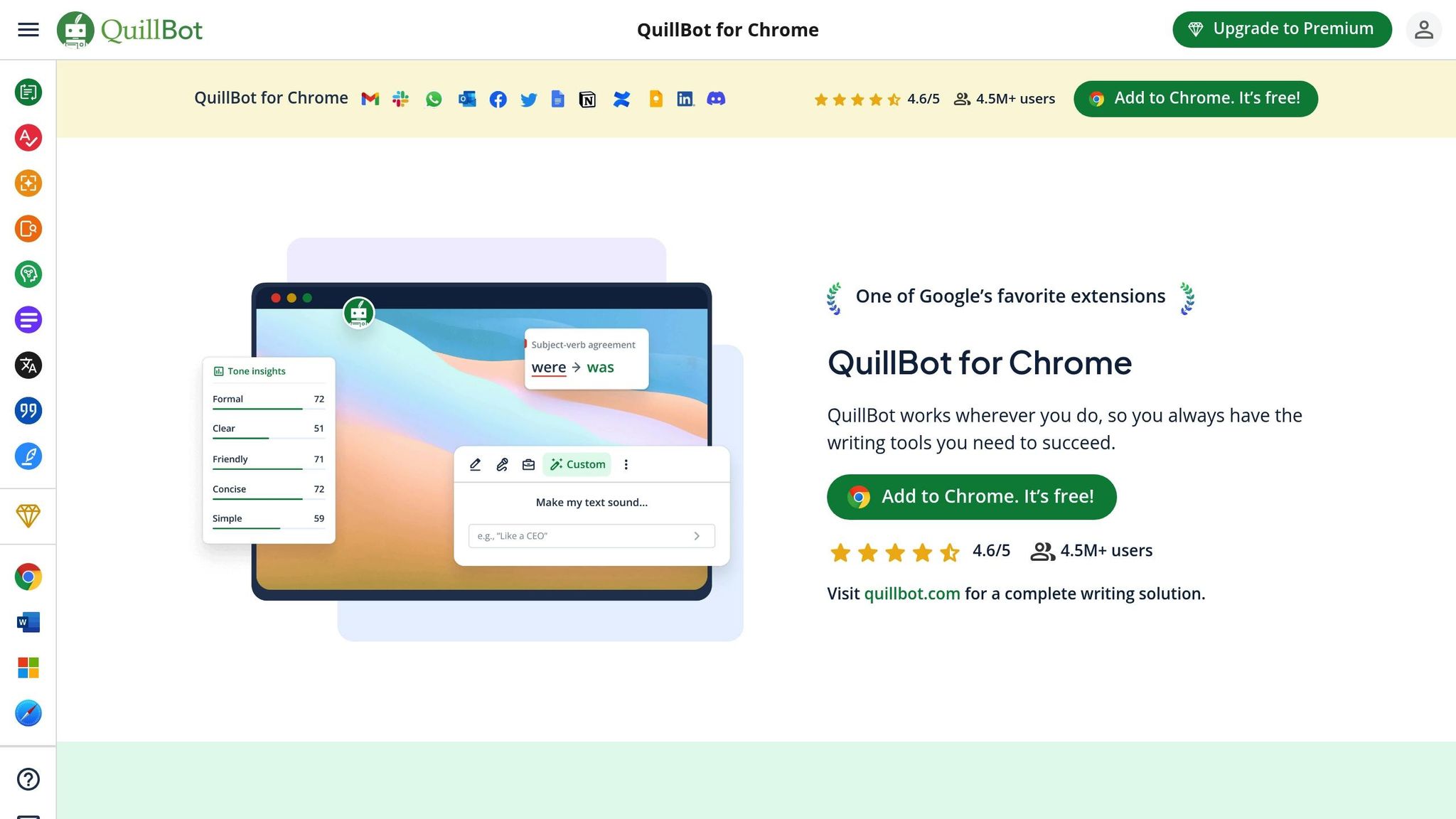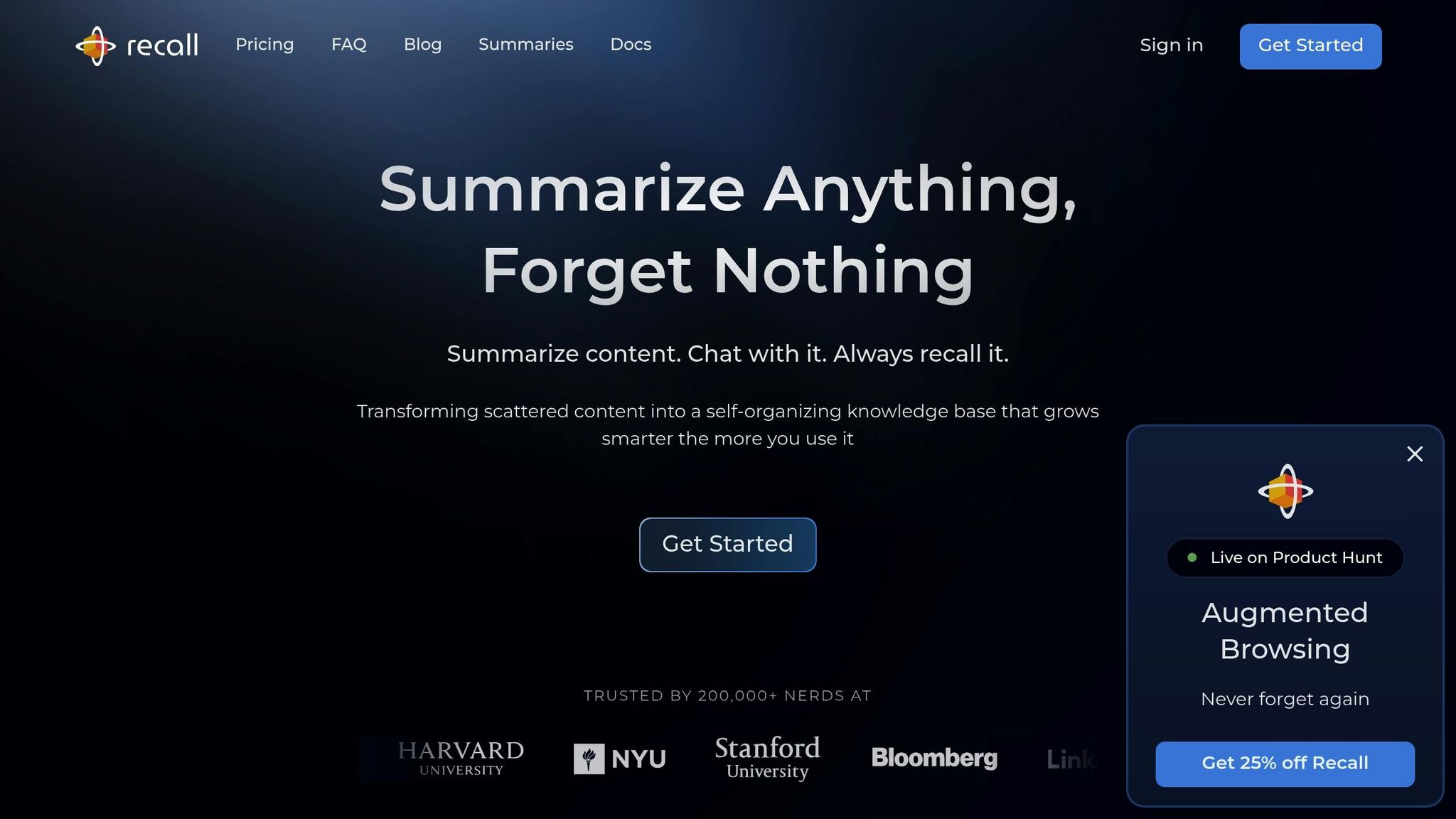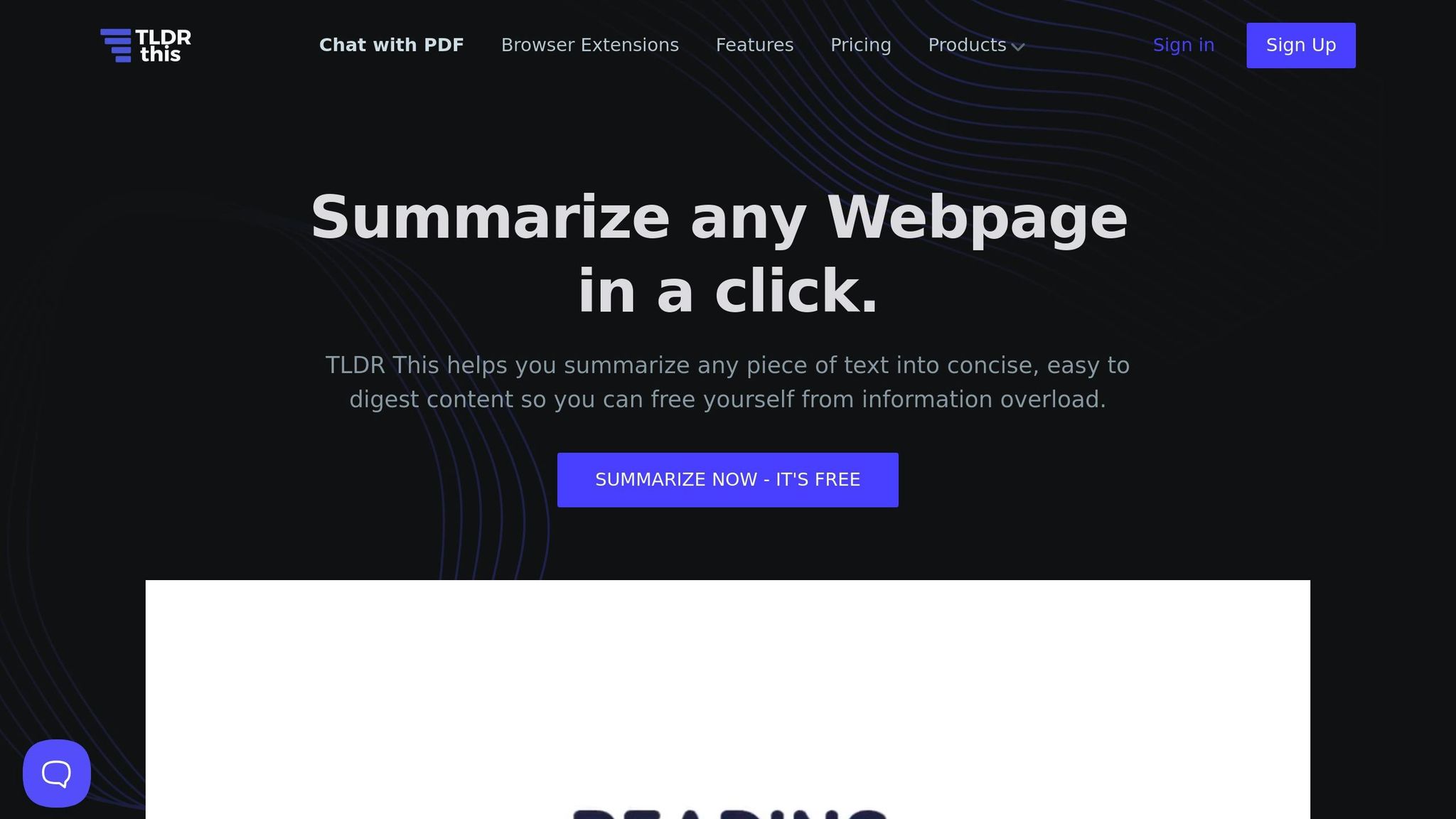
5 Best article summarizer to streamline your reading efforts in 2025
Tanvi Mehta
Jun 7, 2025
Struggling to keep up with endless reading? Article summarizers powered by AI can help you quickly digest long texts by pulling out the key points. Here are 5 top tools to simplify your reading in 2025:
Stacks: Organizes and summarizes content with AI, ideal for teams and professionals. Free plan available; premium starts at $9/month.
QuillBot Summarizer: Chrome extension offering short, medium, and long summaries. Free for up to 300 words; premium costs $9.95/month.
Recall AI Chrome Extension: Summarizes webpages in real time. Free plan includes 10 summaries/month; Pro starts at $7.99/month.
AI Summarizer: Processes PDFs and more with advanced NLP. Free for 15 articles/month; unlimited plans start at $9.99/month.
TLDR This: Simplifies content into bullet points or paragraphs. Free for 5 summaries/day; premium costs $9.99/month.
These tools save time for professionals, students, and researchers. Whether you need quick insights or detailed overviews, there’s a summarizer for you. Choose based on your needs - collaboration, integration, or offline use - and make reading more efficient today.
5 Best AI Summarization Tools in 2024
1. Stacks

Stacks is a platform designed to manage digital content with the help of AI. It uses intent recognition and natural language search to simplify and summarize lengthy content.
Key Features:
AI-driven intent recognition to pinpoint important details
Natural language search for quick content discovery
Tools for real-time collaboration among teams
Customizable sharing and workspace options
Automatically organizes saved content by topic for easier navigation
Benefits:
Maintains context while managing notes, bookmarks, links, and files
Easy-to-use interface with a focus on privacy and content ownership
Offers analytics to monitor content engagement and usage
Pricing Plans:
| Plan | Cost | Features |
|---|---|---|
| Free | $0 | Unlimited resources, 1 personal workspace |
| Be Productive | $9/mo | 50GB storage, unlimited personal workspaces |
| Be Collaborative | $29/mo | 500GB storage, team tools, advanced analytics |
| Be Creative | $39/mo | Unlimited public collections, branded options |
Stacks’ AI-powered tools streamline content curation and sharing, making it ideal for professionals, researchers, and content creators. The platform excels at managing various types of content, from academic papers to news articles, saving users time while keeping them informed.
Its collaborative features are particularly useful for teams handling large volumes of information, offering an efficient way to share and organize content.
Next up, take a look at QuillBot Summarizer to see how AI can help with paraphrasing and creating tailored summaries.
2. QuillBot Summarizer

QuillBot Summarizer is a Chrome extension powered by AI, designed to turn long articles into brief, easy-to-digest summaries while keeping the main points intact.
Key Features:
AI-driven for precise and clear summaries
Offers short, medium, and long summary options
Works in multiple languages
Seamlessly integrates with tools like Google Docs and Microsoft Word
Includes a readability score tool
Why It Stands Out:
Cuts down reading time by focusing on the most important details
Ensures summaries stay contextually accurate
Works well for both technical and academic material
Regular updates improve its performance
Advantages:
Produces summaries quickly and accurately
Includes templates tailored to specific content types
Drawbacks:
Premium subscription needed for full features
Limited functionality when offline
Pricing Options:
Free: Summaries for up to 300 words
Premium: $9.95/month (billed annually) – unlimited word count and multi-language support
Professional users benefit from templates for research, news, legal, technical, and business documents. Plus, its integration with Google Docs and Microsoft Word simplifies workflows for handling large volumes of text.
Next, take a look at the Recall AI Chrome Extension for instant webpage summarization.
3. Recall AI Chrome Extension

The Recall AI Chrome Extension offers real-time webpage summaries directly in your browser. It simplifies content without skipping over important details.
Key Features:
Identifies and processes key paragraphs
Adjustable summary length
Supports over 15 languages
Summarizes pages with a single click
Syncs with note-taking tools
Uses advanced language processing
Delivers context-aware results
Includes readability scoring
Works across different browsers
Receives frequent updates
Pros:
Quick and efficient
Easy-to-use interface
Supports keyboard shortcuts
Multiple export formats
Offline functionality after setup
Cons:
Limited features in the free version
Some tools only work with Chrome
May struggle with complex layouts
Pricing Options:
Basic Plan: Free, includes 10 summaries per month
Pro Plan: $7.99/month for unlimited summaries
Team Plan: $14.99 per user/month with added collaboration tools
Next, take a look at how AI Summarizer can provide instant insights and smoother workflows.
4. AI Summarizer

AI Summarizer uses advanced natural language processing (NLP) to create clear, context-focused summaries in just seconds.
Key Features
Summaries in various formats and lengths (25–75% of original content)
Compatible with PDFs and other documents
Cloud storage integration for easy access
Works offline when needed
Readability metrics included
Citation generator built-in for quick references
Supports over 40 languages
Tools for team collaboration
Analytics dashboard for tracking usage
Pros
Delivers accurate and reliable summaries
Processes content quickly
Simple and user-friendly interface
Offers flexibility in formatting
Regular updates with new features
Strong privacy protections
Cons
Limited support for mobile devices
Struggles with complex layouts
API access not included in basic plans
Pricing Options
Free Plan: Summarize up to 15 articles per month
Personal: $9.99/month for unlimited summaries
Professional: $19.99/month with advanced tools
Enterprise: Custom pricing, including dedicated support
Next: TLDR This.
5. TLDR This

TLDR This simplifies lengthy content into short, easy-to-digest summaries while keeping the main points intact.
Key Features
Create summaries instantly with adjustable length settings
Chrome extension for quick, one-click summarization
Batch process up to 50 documents at a time
Adjust summary length (10%–50% of the original text)
Offline functionality with automatic syncing
Works with Google Docs, Medium, and scientific journals
Includes text-to-speech support
Offers multiple summary formats (bullet points or paragraphs)
Supports over 40 languages
Provides word count and readability metrics
Share summaries via links
Connects with popular note-taking apps
Pros
Processes content quickly
Clean, easy-to-use interface
Delivers accurate summaries for news articles
Compatible with various file formats
Offline functionality for the browser extension
Regular updates to features
Cons
Limited options for customization
No built-in team collaboration tools
Basic analytics features
Mobile app performance needs improvement
Pricing Options
Basic: Free, includes up to 5 summaries per day
Plus: $4.99/month for 100 summaries daily
Premium: $9.99/month for unlimited summaries
Team: $24.99/month for up to 5 users
Next, learn about the groups that benefit the most from using article summarizers.
Target Users for Article Summarizers
AI summarizers are incredibly useful for a variety of professionals and learners. Here’s a breakdown of who benefits most:
Academic Professionals
Researchers rely on summarizers to quickly go through academic papers, review literature, and create concise summaries for their work.
Business Professionals
Executives and managers use these tools to efficiently review reports, competitor updates, internal documents, and market analyses.
Content Creators and Journalists
Journalists and creators save time by summarizing breaking news, industry trends, background research, and content briefs.
Students and Educators
Students use summarizers to organize study materials, condense notes, and prepare for exams. Educators use them to streamline lecture notes and reading materials.
Legal Professionals
Lawyers and legal teams use summarizers to analyze case law, process lengthy legal texts, and draft case briefs.
With these key user groups in mind, let’s dive into what article summarizers are and how they work.
Understanding Article Summarizers
Article summarizers simplify long pieces of content into brief summaries by utilizing natural language processing (NLP) and machine learning to identify key ideas. Dr. Sarah Chen, Lead AI Researcher at MIT's Language Processing Center, highlights their progress:
"Modern article summarizers have evolved beyond simple keyword extraction. They now understand context, identify key arguments, and can even maintain the author's tone while condensing content to its essential elements."
These tools operate in two main ways: extractive methods, which pull key sentences directly from the text for precision, and abstractive methods, which rewrite content into shorter, more natural summaries.
Thanks to advancements in transformer-based deep learning, summarizers can now tackle complex documents in various languages and styles while preserving their meaning.
With a grasp on how these tools work, let’s explore the best situations to use them.
Best Times to Use Summarizers
Summarizers are perfect for breaking down lengthy texts when you're pressed for time. Here are some situations where they can save the day:
Academic Research: Quickly pull key insights from academic papers to simplify literature reviews and choose relevant sources.
Market Reports: Extract the most important points from market reports to make faster, more informed decisions.
Meeting Prep: Summarize briefing materials to prepare thoroughly for meetings without spending hours reading.
Content Curation: Highlight key takeaways from interviews or reports to focus your storytelling and streamline content creation.
Legal Documents: Review long contracts or case law to pinpoint critical details before diving into a deeper analysis.
Up next, we'll explore where you can find these summarizer tools.
Where to Find Summarizer Tools
Looking for summarizer tools? Here’s where you can get them:
Browser Extension Stores
Check out the Chrome Web Store or Firefox Add-ons for tools that work directly in your browser.
Official Websites
Visit official websites for access to full features and updates. For instance, Stacks (betterstacks.com) offers its complete suite on its web platform.
Mobile App Marketplaces
Grab mobile-friendly summarizers from the Apple App Store or Google Play for quick access on your phone.
Desktop Applications
Get desktop versions from the Microsoft Store (Windows), Mac App Store (macOS), or Linux package managers like apt and snap. These are great for offline use or processing multiple files.
API Marketplaces
Developers can explore API marketplaces such as RapidAPI or Google Cloud Marketplace to integrate summarization features into their own applications.
Benefits of Using Summarizers
Now that you know where to find these tools, let’s break down what makes them so useful.
Article summarizers can save time and effort by condensing information without losing its meaning.
"Modern article summarizers have evolved beyond simple keyword extraction. They now understand context, identify key arguments, and can even maintain the author's tone while condensing content to its essential elements", explains Dr. Sarah Chen, Lead AI Researcher at MIT's Language Processing Center.
Key Advantages
Save Time and Cut Costs: Summarizers can reduce reading time by up to 30%. They also lower the cost of processing content, freeing up teams to focus on analysis instead of spending hours on review.
Better Information Retention: By presenting the main ideas clearly, these tools help users remember and apply key concepts more effectively.
Faster Decision-Making: Summarizers provide concise overviews, allowing managers and executives to make quicker, data-driven decisions.
Simplify Complex Language: They can translate technical terms into plain language, which is especially helpful for international teams or non-native speakers.
Reduce Stress: By streamlining the flow of information, summarizers help professionals avoid feeling overwhelmed and meet deadlines with less pressure.
"According to Dr. Alex Rivera, CTO at DataInsights, 'Summarization tools can cut weekly research hours in half, directly boosting team productivity.'"
Next, we’ll explore how summarizer technology achieves these results.
How Summarizer Technology Works
Now, let’s dive into how summarizer technology actually operates:
Modern summarizers use advanced natural language processing (NLP) and machine learning (ML) systems to break down and analyze text. The process starts with tokenizing the text into smaller, manageable units. Then, semantic analysis and entity recognition help identify the context and key details. Finally, transformer-based models generate a concise version of the original content.
These tools are designed to work across multiple languages while maintaining the original tone and style. They’re especially useful in professional settings, as they can handle complex technical terms with precision, making them a go-to solution for specialized content in various industries.
Conclusion
AI summarizers simplify lengthy texts into concise overviews, saving professionals time while keeping essential details intact. These tools are especially useful for those needing to stay updated on industry trends without diving into full-length articles.
Options like Stacks, QuillBot, Recall AI, AI Summarizer, and TLDR This each bring different features to the table. Choose one based on your specific needs - whether for academic research, business updates, or news - and make it part of your routine. However, don’t forget that detailed reading is still important for deeper understanding and analysis.
Up next, find answers to common questions about picking and using summarizers effectively.
FAQs
How can I choose the best article summarizer for my reading habits and needs?
Choosing the right article summarizer depends on your specific goals and preferences. Start by identifying what features matter most to you - such as ease of use, supported platforms, or advanced customization options. If you frequently read academic papers or research-heavy content, look for a summarizer that supports citation integration or works with scholarly sources. On the other hand, if speed and simplicity are your priorities, opt for a tool with a user-friendly interface and quick processing.
Consider testing a few options to see which one aligns with your workflow. Many tools offer free trials or basic versions, so you can evaluate them without committing to a purchase. Ultimately, the right summarizer should save you time, improve comprehension, and fit seamlessly into your reading routine.
What is the difference between extractive and abstractive summarization, and how do they impact the quality of summaries?
Extractive summarization involves selecting key sentences or phrases directly from the original text to create a summary. This method ensures accuracy since it uses the exact wording from the source but may lack coherence or flow if the extracted sentences don't connect well.
Abstractive summarization, on the other hand, generates new sentences by rephrasing or synthesizing the content of the original text. While this approach can produce more natural and concise summaries, it relies heavily on the quality of the summarization algorithm and may introduce inaccuracies if the system misunderstands the source material.
Both methods have their strengths: extractive summarization is ideal for preserving factual accuracy, while abstractive summarization works well for creating more human-like, concise summaries. The choice depends on the context and the desired summary quality.
Can article summarizers accurately process complex or technical content without losing critical details?
Yes, many article summarizers are designed to handle complex or technical content effectively. Advanced summarizers use AI algorithms and natural language processing (NLP) to identify key points while preserving essential context and details. However, the accuracy often depends on the quality of the tool, the complexity of the content, and the specific summarization method used.
For highly specialized or technical material, it may be helpful to review the summary alongside the original text to ensure no important details are missed.